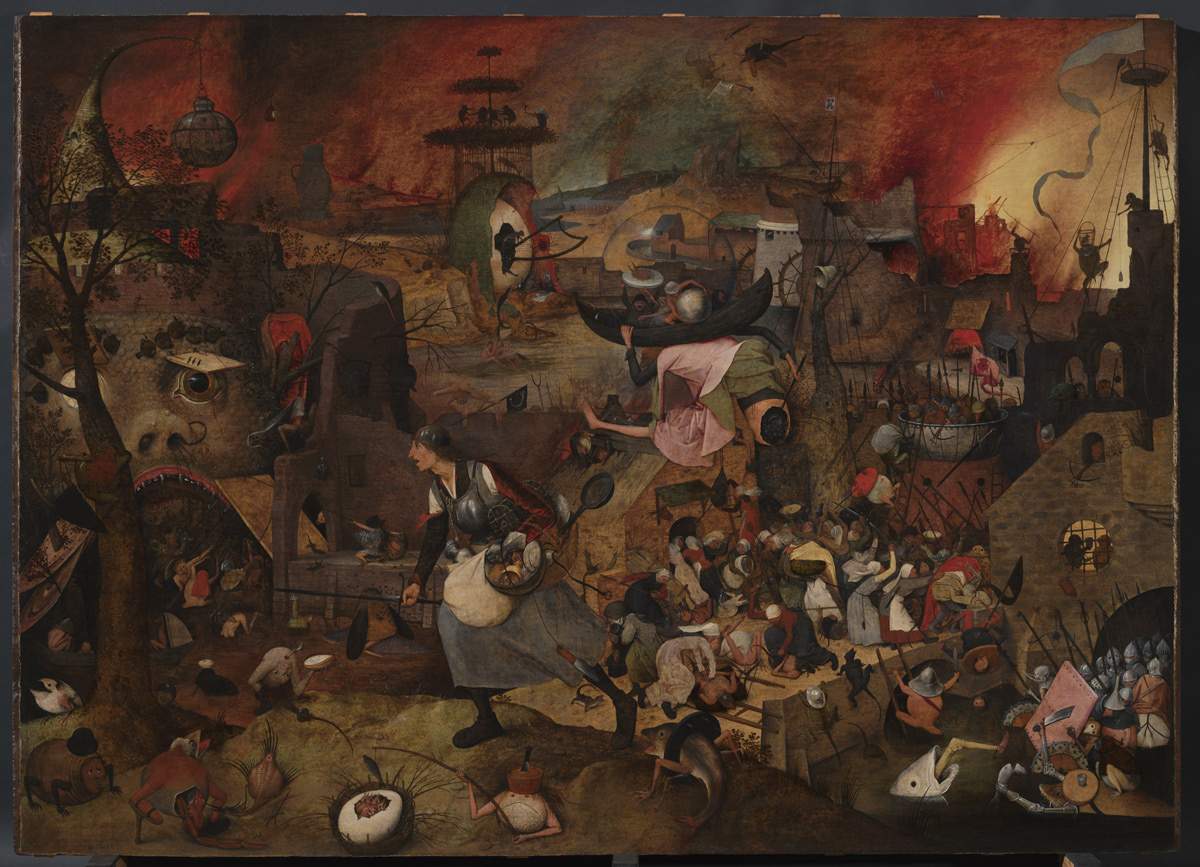For Flanders, 2019 will be the year of Pieter Bruegel the Elder (Breda, c. 1525 - Brussels, 1569). Indeed, next year will mark anniversary number 450 of the artist’s death, and to mark the occasion Flanders is dedicating a series of events to Bruegel the Elder as part of the three-year Flemish Masters 2018-2020 project. One of the highest and most anticipated moments will be the return of the Dulle Griet to the Mayer van den Bergh House-Museum in Antwerp: in fact, the extraordinary restoration of Bruegel’s masterpiece has been completed, and in February 2019 the painting will be returned to the Flemish museum, which also holds another important work by the artist, The Twelve Proverbs of 1558. The Dulle Griet is named after a character from Flemish folklore, the witch Margaret the Mad, a probable personification of avarice or a popular alteration of the figure of St. Margaret of Antioch, the saint who defeated the devil simply by praying. Bruegel probably thought and painted her as part of a series, with other works such as the Fall of the Rebel Angels and the Triumph of Death, with which she shares echoes of Bosch’s imagery.
The restoration of the painting, which began in 2017, was conducted by experts from KIK-IRPA, the Brussels-based Royal Belgian Institute for Cultural Heritage, and led to some important discoveries. The first: it was not Pieter Bruegel who drew the inscription “Dul” on the canvas that has always been attributed to him (the inscription was in fact affixed later and may even be a set of meaningless letters, drawn randomly elsewhere in the painting as well). Moreover, the removal of the layers of color using innovative techniques developed by KIK-IRPA, allowed the painting’s dating to be corrected, moving it from 1561 to 1563. A gap of two years that also calls into question the place where Bruegel gave birth to his Griet, and that could be Antwerp or Brussels: in fact, we know that in 1563 Bruegel moved from Antwerp to the capital. In August, the painter married Mayken Coeke in the Kappellekerk in Brussels, but from certain documentation we know that the marriage announcement took place in Antwerp Cathedral in July of that year. However, it remains impossible, for now, to trace the exact date when Bruegel moved from one city to another and thus to establish where the work saw the light of day.
Finally, great attention has also been paid to the study of the color palette used by Bruegel. Before the restoration, the painting was characterized by its dark and sinister tones: dark red sky with brown spots, two shades of blue, and green without luster, starting with Margaret’s dress itself. Today we can admire a Dulle Griet with decidedly brighter colors. This achievement was also the result of studying a drawing with an identical subject that turned out to be an exact copy of Dulle Griet executed by Pieter Bruegel the Younger (Brussels, 1564 - Antwerp, 1638). This drawing, kept at the Kunstplaats in Düsseldorf, unlike the original work by Bruegel the Elder, has preserved its colors intact and is therefore a unique and detailed record of the palette originally used for the Dulle Griet. By removing the amber patina that had yellowed all its elements, the restoration restored the canvas to a fresher look and now reveals iconographic details hidden for centuries such as a teddy bear and a beautiful landscape in the background.
Finally, the Dulle Griet, in October 2019, will be the focus of an exhibition entitled From Fouquet to Bruegel. The Mayer van den Bergh Museum, produced in collaboration with the KMSKA (Royal Museum of Fine Arts in Antwerp), and which will display masterpieces from the collections of Fritz Mayer van den Bergh (Antwerp, 1858 - 1901) and Florent van Ertborn (Antwerp, 1784 - The Hague, 1840), the two collectors whose taste and flair helped make Antwerp a capital of Flemish art, and more.
Pictured: the Dulle Griet by Pieter Bruegel the Elder (1563; oil on panel, 115 x 161 cm; Antwerp, Mayer van den Bergh House-Museum) after restoration. Ph. Credit KIK-IRPA
 |
| 2019 will be the year of Pieter Bruegel. His Dulle Griet returns to Antwerp after extraordinary restoration |
Warning: the translation into English of the original Italian article was created using automatic tools. We undertake to review all articles, but we do not guarantee the total absence of inaccuracies in the translation due to the program. You can find the original by clicking on the ITA button. If you find any mistake,please contact us.